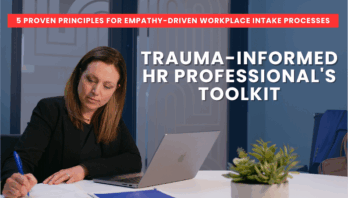In Part 1 of this blog on trauma-informed investigation practices, we discussed actions investigators can take to create safe spaces and build rapport with interviewees by providing them with as much autonomy in the investigation process as possible, by removing surprises, and by offering the opportunity to have a support person present.
In this blog, we’ll look a little closer at trauma-informed practices within interviews themselves.
Tip #4: Choose your words carefully
Language matters. The words we choose in each interaction play an important role in building rapport and trust with the people we interview. This shows up in many simple and complex ways throughout our investigations, and it impacts the way people receive our interactions, and how able or willing they are to share their information.
A simple example: Make sure you refer to people the way they wish to be referred to, whether that is informally by their first name or formally by their last name, and of course, always by their proper pronouns. Similarly, in a complainant’s interview, ensure you refer to the respondent according to the complainant’s wishes.
A complex example: Phrase your questions as neutrally as possible. Consider if your wording could be taken as judgmental or as a questioning of the party’s actions or inactions.
When we investigate allegations of sexual misconduct in a healthcare setting, it’s crucial to our understanding of the events to know what the complainant was wearing during the incident. This question has the potential to be very charged, given the way complainants’ clothing has historically been used to suggest their fault in criminal proceedings. It can make a big difference to phrase the question without words or intonation that may be received as judgmental, and to ensure the complainant understands why we’re asking.
Tip #5: Set up the hard questions
We often have to ask difficult questions in our interviews; the nature of investigations is to gather all relevant details and clarify any inconsistencies. We can greatly improve how people might receive difficult questions by taking the time to prepare interviewees for these questions and to help them understand why we need to ask them.
Let’s imagine that you are about to ask a complainant specific questions about their concern. A trauma-informed set-up might look like this:
- You tell the complainant that you now have to ask them some detailed questions about their concern; now the complainant has a moment to mentally prepare for the difficult questions.
- You tell the complainant that you appreciate it might be difficult to discuss their concerns, so they can take breaks whenever they need to; now the complainant knows they still have autonomy in the interview process.
- You tell the complainant why you need to ask the questions. For example, “I need to ask some specific questions now to ensure we have a full understanding of your concern. This will help us (or the committee in regulatory investigations) to make an informed decision about these concerns.” Now the complainant has a better understanding of the intention behind your questions.
Tip #6: Ask the hard questions… softly
Trauma-informed interviews begin with letting interviewees tell their stories in the manner and the order they choose, but that often doesn’t lead to the full story. In an effort to practice a trauma-informed approach, some investigators simply ask interviewees to tell them more about their concerns, without detailed prompts or follow up questions. This can lead to information gaps that make it difficult to determine precisely what happened.
Our role is to gather all the relevant information, and this often means asking detailed questions about difficult things. But we want to ask those questions softly, in a trauma-informed, sensitive way. We want to phrase our questions in an open-ended, neutral way that is free of judgment. We want to use a “warmly neutral” tone, avoiding any hint of accusation or condescension, and we want to keep our body language open, projecting a calm, open demeanour, with our arms, hands, and face relaxed.
Don’t shy away from the hard questions; they often lead you to the crux of the matter and determine whether there’s sufficient information to make an informed decision. But consider how your delivery impacts the person sitting in front of you, and how you can ask those necessary questions softly.
An Empathetic Balance
A trauma-informed approach involves balancing the rigorous demands of an investigation with the potential vulnerability of the person before you. Remember that everyone you interact with is an individual with a unique and complex set of needs, wants, and challenges, and that every interviewee deserves the dignity of a clear, impartial, thorough investigation.






